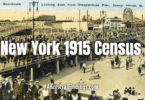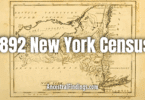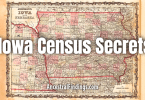The 1950 U.S. Census is the most recent one released to the public, and it marks the end of an era and the beginning of another. Taken just five years after the end of World War II, it captures a nation in transition—from wartime sacrifice to peacetime prosperity. Suburbs were growing, baby carriages were rolling down sidewalks, and television sets were beginning to flicker in living rooms. If the 1940 census shows a country on the brink, the 1950 census shows what happened after the leap.
This census is a cornerstone for modern genealogy. It connects living generations with those who came before in a way that no earlier census can. It may even include your parents, grandparents, or someone you knew personally. That makes it more than just a record—it’s a snapshot of real lives in neighborhoods that may still feel familiar.
Historical Background of 1950
When enumerators started on April 1, 1950, the U.S. population had reached just over 150 million. America had emerged from World War II as a global power, and its domestic life was shifting rapidly. The GI Bill had helped thousands of veterans go to college and buy homes. Entire communities were being built to house young families. The economy was booming, and a new American identity was forming—optimistic, mobile, and increasingly suburban.
Though the Cold War was beginning to cast a shadow, everyday life was largely focused on rebuilding and starting fresh. Men returned from war and resumed civilian work. Women who had entered the workforce were adjusting to new expectations at home or continuing to work in growing office and service industries.
What Was Asked in the 1950 Census?
The 1950 census is detailed, and for genealogists, it offers both broad trends and very personal insights. Here are some of the questions it asked:
- Name, relationship to head of household, race, sex, age, and marital status.
- Place of birth.
- Whether the person was living in the same house a year ago.
- Whether they were living in the same county a year ago.
- Employment status, occupation, industry, and hours worked the previous week.
- If not working, whether they were looking for work.
- School attendance during the last two months.
- For those 14 and over: military service in World War I, World War II, or any other service.
- For women: how many children they had ever borne (for a sample of the population).
- For a 20 percent sample: additional questions about income, previous employment, and migration.
Enumerators were also instructed to follow up on absent household members—students living elsewhere, servicemen, and the institutionalized. This extra layer of effort helps capture a more complete picture of American life at mid-century.
Digging Deeper: Research Techniques for the 1950 Census
Compared to earlier censuses, the 1950 census demands a slightly different approach. For starters, it was the first census to use sampling extensively. Not every person was asked every question. Around 20 percent of respondents received supplemental questions that dug deeper into income, education, prior employment, fertility (for women), and migration. This creates a two-tiered system: one level of basic data, and another richer layer if your ancestor happened to be in the sample.
One of the most useful new features is the question about residence a year earlier. This one question can help you reconstruct a family’s movement between 1949 and 1950. It can suggest job relocations, postwar migrations, or economic recovery after years of instability. This five-year window (1935–1940–1950) can now be extended to a more granular level, especially when combined with city directories, school records, and draft cards from World War II and Korea.
Another tip: pay attention to how occupations and industries are recorded. The 1950 census begins to reflect the rise of white-collar jobs, corporate positions, and administrative work. You might see terms like office manager, data processor, or claims clerk—jobs that were rare or nonexistent in 1930. Comparing the 1950 census against earlier ones can highlight how a family shifted economically or socially. A laborer in 1930 might now be a homeowner working in insurance, a testament to economic mobility.
The information about hours worked is particularly valuable. It helps distinguish between full-time and part-time work, and it may help explain why some family members contributed more income or had different social statuses. This can be helpful in interpreting wills, property records, or even family stories.
Use the veteran question to tie military service directly to civilian life. If you’ve already accessed a family member’s WWII draft record or service file, this census lets you place them in the context of peacetime America. Were they working? Were they in school? Were they living with parents or starting families of their own? These connections are powerful when building biographies or confirming timelines.
Family Structures and Social Clues
The postwar era brought dramatic shifts in household structures. Younger families were moving into their own homes more quickly. You may see smaller family units than in 1930 or 1940. At the same time, aging parents who lost spouses or fell on hard times often moved in with adult children.
Use the census to trace these multi-generational households. Look closely at surnames of all individuals in a household. A different last name may indicate a married daughter or a boarder. Don’t skip the people listed at the bottom of the page—domestic workers, roomers, or extended family members sometimes appear without much context, but they can reveal more than they seem at first glance.
And remember: if a family is missing someone you expect to be there, check institutional schedules. College students, prisoners, people in hospitals, and military personnel may be listed elsewhere. These absences are sometimes the best leads you’ll get to find someone who seemed to vanish.
Cultural and Social Context Hidden in the Census
The 1950 census doesn’t ask directly about race relations, technology, or the Cold War, but the footprints of those issues are all over the records. In many cities, housing patterns reveal redlining or segregation. Neighborhoods are divided clearly along racial lines, which can give you context when tracking a family’s location or change in address over time.
Technology is also part of the backdrop. While not listed explicitly, this was the first census where television, refrigerator, and telephone ownership became common. This silent shift shows up in household structure and employment types. People were increasingly working in communications, electronics, or media-related jobs.
You’ll also see the early signs of the Civil Rights Movement and the coming cultural shifts of the 1960s. In the census itself, this is subtle—more African American families in Northern cities, more women working as professionals, and a slow rise in college attendance.
Why the 1950 Census Deserves Special Attention
Because it’s the most recent public census, it bridges the past and the present more clearly than any before it. It’s the one that gets us closest to the world we know, and it helps us understand how our families made the final steps into the modern era.
For researchers, it’s an opportunity to build out timelines with precision. You can link census data with postwar draft registrations, GI Bill applications, marriage records, birth certificates, and local news clippings. These records form a cluster that gives clarity to an otherwise foggy period in family research.
So take your time with the 1950 census. Don’t just note names and ages. Look at movement, work habits, household relationships, and educational progress. Pay attention to what’s said—and what’s not. Compare it with earlier records to find direction, and with later documents to see change. This census is more than a list. It’s a mirror reflecting a nation finding its footing again.
And in that reflection, you’ll likely find more than just ancestors—you’ll find pieces of yourself.






